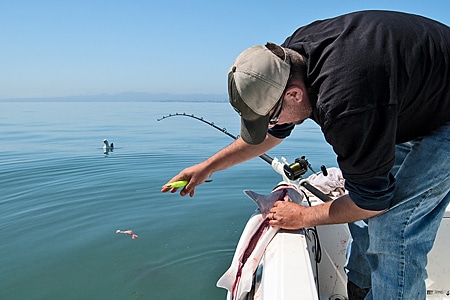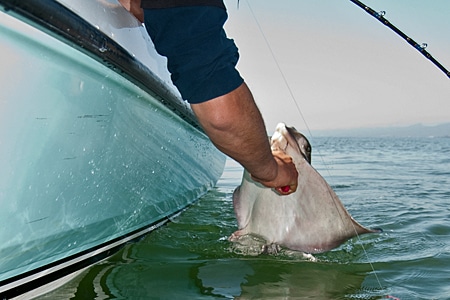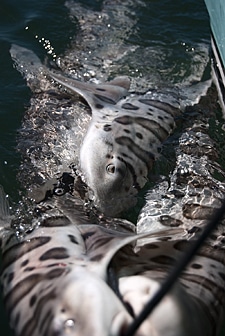As an Amazon Associate I earn from qualifying purchases.

Some days you’re the dog, some days you’re the fire hydrant. This past Wednesday on San Francisco Bay, we were the dogs. Holly and I headed out early that morning to meet our friend RJ Waldron of Northwind Outfitters for our annual shark fishing trip. We love fishing for sharks — me because I’ve been doing it since I was a teenager, Holly because she loves to eat shark.
Before you get your panties in a wad, know that we were fishing for leopard, soupfin, smoothound and sevengill sharks: None are in any danger of overfishing, and our primary quarry, the leopard shark, is considered a species of “least concern” by the International Union for Conservation of Nature. Now I am as appalled as the next person by the destruction of our worldwide shark population, but that fishery is huge, commercial and for species other than those we target. Enough said.
Why do I love shark fishing? Maybe it’s a lifelong fascination with the movie “Jaws.” Family lore has it that Robert Shaw, the actor who played Capt. Quint, is a second cousin. More than one person has noticed a passing resemblance between Shaw’s Quint and me. A more likely reason I get a jones for sharking it’s because it is the highest form of the style of fishing I love most: Bait fishing.
I am not a fishing gearhead. For fishing off a boat, I’ve used one rod, a Penn Long Beach, for close to 20 years. I’ve changed reels on it twice in that time. I tie basic knots, use rudimentary tackle and catch a helluva lot of fish. I’ve fed myself almost solely off the fish I’ve caught for more than one year of my life. Bait fishing to me is pleasingly low-tech. I need not keep up with fishing fashion to catch my dinner. All I need is a sharp hook, a hunk of lead, and something bloody on the end of that hook. In the case of our sharks last week, that would be a dead midshipman, which is an odd sort of saltwater bullhead.
It did not take long for us to catch our first leopard shark. R.J. was still setting up the second rod when the first one bent double. You need to know that when you fish big baits you need to wait until the fish swallows the bait before setting the hook — otherwise he’ll spit it out or you will pull it right out of his mouth when you try to set. So you need to be patient. Bounce. Bounce, bounce. WHAM! Now you set the hook. And hold on.
Sharks are, as a rule, willful and sullen. They’re head-shakers who want to grab your bait, tear it to pieces and swim away. To catch them, you need to be as willful as they are, keeping your line tight and giving the shark no ground. Eventually, one of you will tire. In the case of three-foot leopard sharks, they tire first. Always. But should you hook a 10-foot sevengill shark, it’s an open question who gives up first.
But this was a garden-variety leopard, a little over three feet long, and I made short work of him.

Soon after, Holly caught her first shark of the day, another leopard. We were in business! As each shark came on board, we had to kill it and gut it on the spot. This is vital for sharks, skates and rays, which, essentially, pee through their skin. If you fail to gut a shark and cool it down quickly, the meat will stink of ammonia. And ammonia is not good eats. Trust me.

All morning, we probably did not go 20 minutes without a bite. It was one of those days that guides talk about to future customers: “Ya shoulda been here on Wednesday!” Some were undersized soupfin sharks, which are a pretty bronze with gigantic eyes. Sadly, none were really large enough to keep. We caught a few small leopards that we tossed back, and yes, we caught bat rays.

Now theoretically bat rays are edible. I’ve eaten all sorts of skates in my time, and rays are not much different. You slice off the wings and fillet them out. Skate wing and brown butter is a French classic. But you really, really need ice to do that without having the meat stink up the place. And we forgot to bring ice on board. Bummer.

We kept the sharks on a stringer over the side, which worked fine. Soon we had five between the two of us, and decided that was enough. The legal limit would have been six, but we had a ton of shark meat from just five and didn’t need any more.
I write extensively about how to fillet and dress out sharks in my book, Hunt, Gather, Cook, but here’s the short version: Slice off the fins (use for soup if you are into that sort of thing), run the knife down along the cartilage exposed where you cut off the dorsal fin, and fillet the shark out like a normal fish; sharks, as you probably know, have no bones — just cartilage. The skin is tough as nails, so you will need to keep your knife sharp while doing this. Always skin the fillets.
Why? First off, they are so tough you can make leather out of them. Secondly, any mercury or PCBs or other toxins the shark may be carrying concentrate in the skin and belly fat of the fish; this goes for all fish, not just sharks. Leopard sharks in San Francisco Bay have a high enough toxin load that you really want to skin them and use the bellies for bait. Pregnant women and little kids should not eat shark from the bay at all.
Good thing Holly’s not pregnant, and that I am not a small child. We love eating shark, which is firm, but not so firm as swordfish or sturgeon, snow white in color, and loaded with that umami-savoriness that only a fish-eating fish possesses.
We started off our shark fest with a swordfish dish from Southern Italy that I found in the wonderful book My Calabria, from Rosetta Constantino. If you are looking for things to do with shark, look to the Mediterranean, because all cultures there eat lots of tuna and swordfish, and shark is a good stand-in for those fish. The style of our Calabrian recipe is called “glutton’s style,” presumably because it is loaded with all the good things in life: tiny capers, green olives, fresh tomatoes, onions and parsley.

[recipe_name]Calabrian shark, glutton’s style[/recipe_name]
[summary]This is not quite a sauce, not quite a stew. It’s a piece of fish, floured and seared in olive oil, briefly stewed with seared onions, tomatoes, capers and green olives. My version adds a little anchovy and hot chile peppers. If you are wondering how it tastes, it’s a lot like a fish puttanesca: salty, savory, a little sweet-sharp from the tomatoes, a little spicy from the chiles.
I used shark here, but the original dish uses swordfish. Sturgeon, tilefish, tautog, redfish, tuna (especially albacore) and yellowtail would all work here. Basically you want a firm-textured fish, preferably white when cooked.[/summary]
[yield]Serves 4. [/yield]
Prep Time: [preptime time=10M] 10 minutes[/preptime]
Cook Time: [cooktime time=12M] 12 minutes[/cooktime]
- 4 shark steaks, about 1 1/2 to 2 pounds total
- Salt
- 1 cup semolina flour, for dusting
- 4 tablespoons olive oil
- 1 large onion, sliced thinly from stem to root end
- 4 anchovy fillets, mashed
- 1 small hot chile, such as a Thai chile
- 2-3 tablespoons small capers, preferably preserved in salt (and rinsed)
- 1/2 cup chopped green olives
- 1 cup crushed tomatoes
- 1-2 cups diced fresh tomatoes, seeded
- 1/2 cup fresh parsley, chopped
[instructions]
- Salt the shark steaks well and dust in the semolina flour.
- Heat the olive oil in a large saute pan with a lid over medium-high heat. Sear the fish for 1 minute on each side — you don’t want them cooked all the way just yet. Remove the shark to a plate for now.
- Add the onions and saute over high heat for 1-2 minutes before stirring. You want a little sear on the onions, here and there. Now stir them well, add the anchovy and chile, and cook for another 3-4 minutes, until soft and beginning to caramelize. Add the capers and green olives and crushed tomatoes and stir well. Add the shark back to the pan and turn to coat. Cover the pan and turn the heat to low. Cook 3-6 minutes, depending on how thick the fish steaks are.
- Uncover the pan, add the fresh tomatoes and parsley, cover again and cook for 2 minutes more. Serve hot or at room temperature.
[/instructions]





Just have to say – thank you for this recipe! It has become one of my go-to recipes. We, my Italian boyfriend and I, love it. Easy and delicious. Thank you and happy fishing!
I eat dogfish regularly when I catch them, they are a small species of shark. To make sure there’s no taint of ammonia I freeze the fillets or chunks of shark for at least a week before thawing and cooking. It works much better than any other tip I’ve had, such as soaking in milk.
Tried this the other night. We have had shark before, and love it. The sauce was pretty acidic, but I mellowed it out a bit with some bacon pieces that I cooked at the beginning just in case. As with most tomato sauces, this seriously rocked the next day.
Just found this site about 3 weeks ago and am really enjoying it. Keep up the good work!
Great looking recipe- can’t wait to try it with the smooth dogfish sharks I often catch. The acid in the tomatoes should work well to handle any remaining ammonia odors, if any are there after gutting & icing immediately. The last two I caught were filleted, chunked and marinated in a mixture of lime juice, fish sauce, minced red (ripe) jalepeno pepper and garlic with a bit of sugar to balance and grilled on skewers. Those little sharks are really outstanding fish; people who dismiss them as trash fish don’t know what they’re missing.
I searched the online Barnes and Noble site and your book was out of stock in a 50+ mile radius of my city. They either sold all of the copies or didn’t feel the need to carry it. I felt the need to purchase it and add it to my treasured collection. God Bless You Hank, you’re a man after my own heart!
Todd: It is indeed a crap shoot, but here is a study on toxicity in San Francisco Bay fishes done by the California EPA. Basically sharks are in the iffy zone, with striped bass and a few other commonly eaten species. Toxin load will change depending on individual fish, location where it is caught, and season. In general, leopard sharks caught outside the Bay are cleaner than those in it.
Hank-
Wondering if you know the actual toxin loads of the fillets so as to compare acceptable levels rated by FDA (or whomever)? I am sure it may be a crap-shoot with varying samples, but I guess that’s what a mean average is for. Do you know of any recent research out there posting results?
That being said, I reckon fresh shark caught and prepared quickly in your hands is most likely a lot safer, more humane, and worry free than what’s out there. A perfect example to that is when I sailed down to Mexico – all the long liners in their pangas (open sea-going boats) just tossed in the Dorado on the floor sans ice – for the 4 hour ride back to shore. That fish got cooked on the way home man – and there’s no way that’s adding the 5th element of flavor!
E. Nassar: No worries, we all draw boundaries. I won’t eat cats, even though I’ve heard from many sources that mountain lion tastes like pork. I choose to not eat them. Ditto for dogs.
Rita: Thanks for the clarification — I love that I have smart readers! I do know that methylmercury will bind with proteins, so you can’t really avoid it altogether. Still, the toxin load of a skinned fillet (relatively fat free compared to the belly) will be a lot lower than one with skin-on.
Stan: A fellow reader (thanks Andrew!) sent me this academic paper about urea synthesis in sharks, skates and rays. Hope that helps!
“Secondly, any mercury or PCBs or other toxins the shark may be carrying concentrate in the skin and belly fat of the fish; this goes for all fish, not just sharks.”
This statement is only partially correct. PCBs and other lipophilic toxicants (many pesticides) will be concentrated in the fat of the fish. Methylmercury, unfortunately is bound to protein and will be found in the fillets. This is not just for shark but applies to other fish (and marine mammals) as well.
Sorry Hank, but there is something unappetizing about eating any shark for me. Makes no real sense, I know, but it’s like eating a bird-of-prey or something. Not judging here of course, it’s more of those odd psychological things I suppose and since all fish are “predators” it really makes no logical sense, but there you have it :).
Nick: You can probably eat hammerheads, technically, but I’ve not heard of anyone doing it.
Stan: No references, but it’s what cartilaginous fish do. They are an order of fish a lot older than the bony fishes, and this method of excretion seems to work just fine for them. I am pretty shocked that the French Laundry would buy stinky skate wings — you can smell it on the meat before it’s cooked.
Sten: Nyah, nyah, nyah-nyah nyah! 😉
‘I am not a fishing gearhead. For fishing off a boat, I’ve used one rod, a Penn Long Beach, for close to 20 years. I’ve changed reels on it twice in that time. I tie basic knots, use rudimentary tackle and catch a helluva lot of fish. I’ve fed myself almost solely off the fish I’ve caught for more than one year of my life.’
Speaking as a fishing gear head, who never catches any fish..
Consider yourself OFF THE CHRISTMAS LIST
SBW
Dear Hank: This “peeing through the skin thing” is very interesting. I once had skate (at the French Laundry no less!) and it was terrible because of the amonia taste. Any other references or info? Thanks, Stan
Awesome! I actually just caught my first shark a few weeks ago. The guide I was with said it wasn’t an edible variety though (hammerhead).
It sure was a blast though. Looking forward to my next trip already where maybe I can snag an edible kind…